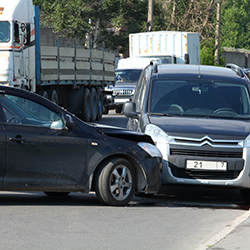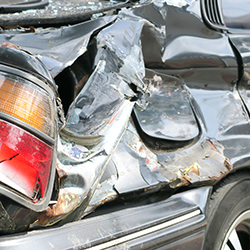Recovering compensation for your Ohio car wreck injuries involves much more than simply claiming that another driver acted carelessly and a crash resulted. Instead, injured plaintiffs must often “paint a picture” or “tell a story” to the judge and/or jury about how the accident came about. This is important for reasons other than keeping the judge or jury interested: the injuries you sustained and the actions you take after your crash must fit with the other evidence and information available about the crash. Therefore, it is important for your car wreck lawyer to determine how your car crash occurred and the type of collision involved in your case.
CONTACT GROTH & ASSOCIATES TODAY REQUEST A FREE CONSULTATION
COMMON CAR ACCIDENT TYPES IN OHIO
Your car crash – as well as any of the other hundreds of thousands of car crashes that occur in Ohio in any given year – can be described using one or more of the following classifications:

- Head-on collision: A head-on collision occurs when two or more vehicles collide after approaching one another from the front. In a head-on collision, you and the others involved may suffer “whiplash”-type head and neck injuries as the forces involved in the crash forces your heads forward and then backward in a quick, “whip-like” motion. Whiplash can lead to traumatic brain injuries that require prompt treatment lest permanent, disabling harm results. On a positive note, the majority of the safety features in a car are located in the front end of the vehicle. As a result, it may require a much greater amount of force to cause serious harm than in other types of collisions.

- Rear-end collision: In a rear-end collision, one vehicle trailing another runs into the rear of the vehicle immediately in front of it. Like in “head-on” collisions, the risk for whiplash-type injuries and the injuries that can result from such injuries is great. Again, like in head-on collisions the rear of vehicles also contain greater amounts of protection and safety equipment than other parts of the car. While in many cases the driver of the trailing vehicle will be determined to be predominantly (if not exclusively) at fault, drivers in lead vehicles in rear-end collisions may be determined to have contributed to a rear-end collision if (for example) they stop suddenly or do not have working tail lamps or turn signals.

- T-collision: In a T-collision (also called a “t-bone” collision), one vehicle strikes another vehicle at a perpendicular angle so that the two vehicles form a “T” shape. One car sustains damage to its side whereas the other vehicle sustains damage to its front end. These collisions typically occur at intersections and can result from one vehicle failing to obey traffic control signs and signals and/or simply not paying attention to other traffic that is present. The driver whose car is struck from the side is at an increased risk of suffering serious injuries as the side panels of vehicles typically do not contain as much shock-absorbing material and safety devices, which results in more harmful energy being transferred to the driver.

- Chain-reaction collision: In a chain-reaction collision, one vehicle strikes another (typically from behind) and propels that vehicle into yet another vehicle. Depending on the force of the initial collision and the proximity of the vehicles involved to one another, there may be a dozen or more vehicles involved in a chain reaction collision. When you are injured in a chain-reaction collision, it becomes important to determine who was involved in the crash as well as their respective levels of culpability and negligence in order to obtain full and fair compensation.
HOW TO DETERMINE THE TYPE OF COLLISION IN WHICH YOU WERE INVOLVED
In some cases, your memory and the memory of other witnesses will be sufficient to establish what type of crash in which you were involved (and, hence, the type of damage and injuries one might expect to encounter). In other cases in which you do not remember the collision and no witnesses are available, your attorney may nonetheless be able to determine the type of collision based upon:
-
- Damage to the vehicles
- The injuries you sustained
- Photographs of tire marks, debris, or other marks on the roadway
Being able to tell a judge or jury a compelling and factually accurate “story” as to how your crash and injuries came about is critical to increasing your chances of successfully recovering monetary damages for your injuries.
CONTACT YOUR OHIO CAR WRECK ATTORNEY FOR HELP
Groth & Associates is your experienced and dedicated Ohio car wreck law firm. Contact our office as soon as possible following a car wreck. We will help ensure that those responsible for causing the crash and your injuries are held to account for their mistakes and bad decisions. Call us at 419-491-3370 or contact us through our website for help.

